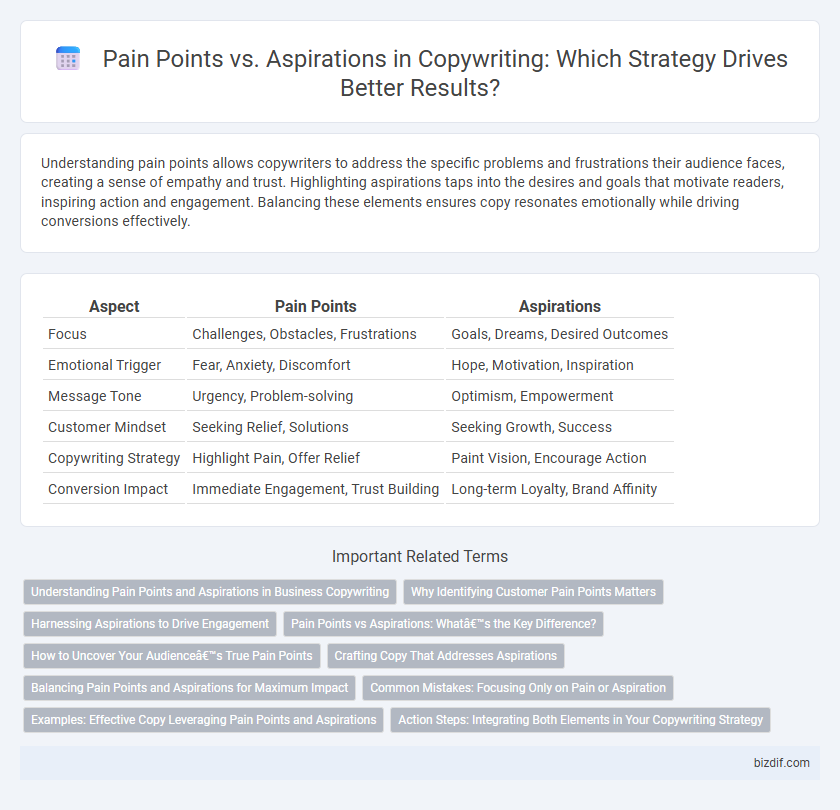Understanding pain points allows copywriters to address the specific problems and frustrations their audience faces, creating a sense of empathy and trust. Highlighting aspirations taps into the desires and goals that motivate readers, inspiring action and engagement. Balancing these elements ensures copy resonates emotionally while driving conversions effectively.
Table of Comparison
| Aspect | Pain Points | Aspirations |
|---|---|---|
| Focus | Challenges, Obstacles, Frustrations | Goals, Dreams, Desired Outcomes |
| Emotional Trigger | Fear, Anxiety, Discomfort | Hope, Motivation, Inspiration |
| Message Tone | Urgency, Problem-solving | Optimism, Empowerment |
| Customer Mindset | Seeking Relief, Solutions | Seeking Growth, Success |
| Copywriting Strategy | Highlight Pain, Offer Relief | Paint Vision, Encourage Action |
| Conversion Impact | Immediate Engagement, Trust Building | Long-term Loyalty, Brand Affinity |
Understanding Pain Points and Aspirations in Business Copywriting
Effective business copywriting hinges on deeply understanding pain points such as customer frustrations, unmet needs, and barriers to purchase, enabling targeted messaging that resonates emotionally. Simultaneously, identifying aspirations like desired outcomes, goals, and values helps craft persuasive content that aligns products or services with the audience's motivations. Balancing these elements enhances conversion rates by addressing immediate challenges while inspiring positive future possibilities.
Why Identifying Customer Pain Points Matters
Identifying customer pain points is crucial for effective copywriting because it directly addresses the challenges and frustrations your audience faces, making your message more relevant and compelling. Understanding these pain points allows you to craft solutions that resonate emotionally, increasing engagement and conversion rates. Focusing on specific problems also helps differentiate your brand by showcasing empathy and expertise tailored to customer needs.
Harnessing Aspirations to Drive Engagement
Harnessing aspirations to drive engagement taps into the deep desires and goals of the target audience, creating powerful emotional connections that motivate action. By aligning messaging with the dreams and values customers hold, copywriters can inspire positive responses and foster brand loyalty. Emphasizing future benefits and transformative outcomes elevates engagement, making content resonate beyond immediate pain points.
Pain Points vs Aspirations: What’s the Key Difference?
Pain points highlight specific problems customers face, driving urgent needs for solutions, whereas aspirations reflect their desires and long-term goals that motivate positive change. Understanding pain points enables targeted, immediate problem-solving copy, while tapping into aspirations fosters emotional resonance and future-oriented engagement. Effective copywriting balances both by addressing current frustrations and inspiring hopeful possibilities.
How to Uncover Your Audience’s True Pain Points
Conduct in-depth customer interviews and analyze feedback from multiple channels such as social media, reviews, and support tickets to reveal authentic pain points affecting your audience. Use surveys with open-ended questions designed to uncover emotional triggers, obstacles, and frustrations that hinder your audience's goals. Mapping customer journeys helps identify critical moments where pain points intensify, enabling targeted copywriting that resonates and drives engagement.
Crafting Copy That Addresses Aspirations
Crafting copy that addresses aspirations taps into the deep desires and goals of the target audience, inspiring action through positive visualization. Highlighting transformative benefits and future success potential creates emotional resonance that outperforms fear-based messaging focused on pain points. This aspirational approach elevates brand perception and drives engagement by aligning copy with customer dreams and long-term motivations.
Balancing Pain Points and Aspirations for Maximum Impact
Effective copywriting balances pain points and aspirations to resonate deeply with the target audience. Highlighting pain points creates urgency and relevance, while showcasing aspirations inspires hope and motivation. This dual approach maximizes emotional engagement and drives higher conversion rates.
Common Mistakes: Focusing Only on Pain or Aspiration
Focusing exclusively on either pain points or aspirations in copywriting limits audience connection and reduces conversion rates. Effective copy addresses both the challenges customers face and their desired outcomes, creating a balanced emotional appeal. Neglecting this dual focus often results in messages that feel one-dimensional and fail to fully engage potential buyers.
Examples: Effective Copy Leveraging Pain Points and Aspirations
Effective copy addresses pain points by highlighting problems like wasted time or high costs, then positions the product as the solution to alleviate these frustrations. Aspirations-driven copy taps into desires such as success, confidence, or freedom, motivating audiences by illustrating how the offering helps achieve these goals. Examples include weight loss ads emphasizing struggles with self-image alongside visions of a healthier lifestyle, or financial services promoting stress relief from debt alongside dreams of financial independence.
Action Steps: Integrating Both Elements in Your Copywriting Strategy
Identify customer pain points and aspirations through thorough audience research to create targeted messaging that resonates emotionally. Craft copy that acknowledges challenges while highlighting desired outcomes, motivating readers to take decisive action. Implement a balanced approach combining empathy with inspiration to drive engagement and conversion effectively.
Pain Points vs Aspirations Infographic

 bizdif.com
bizdif.com